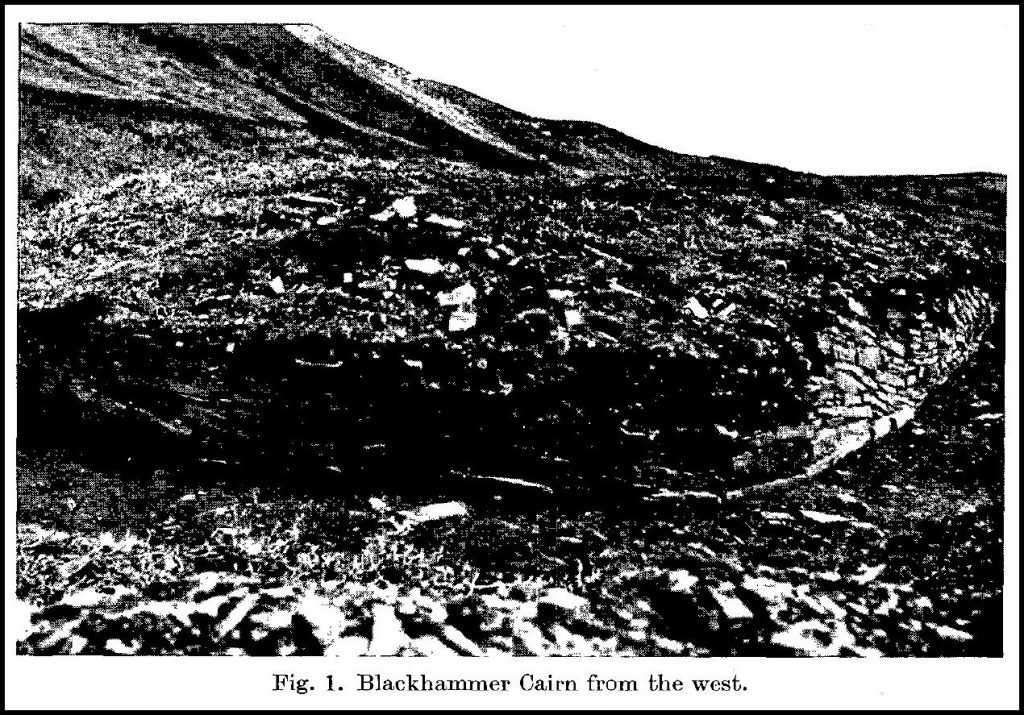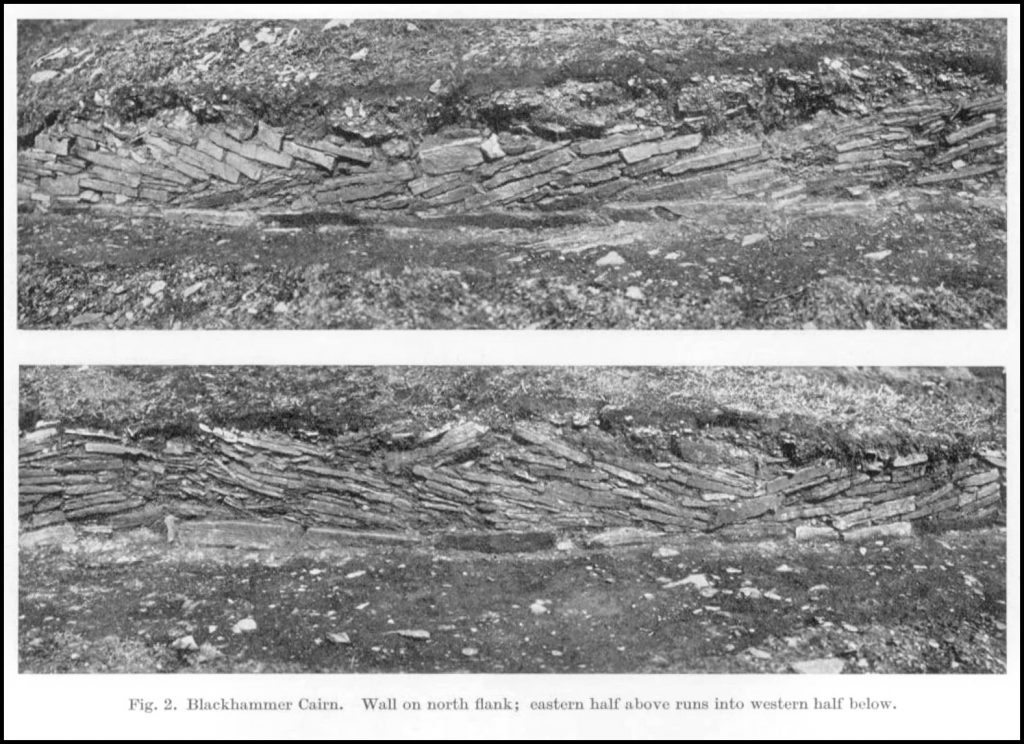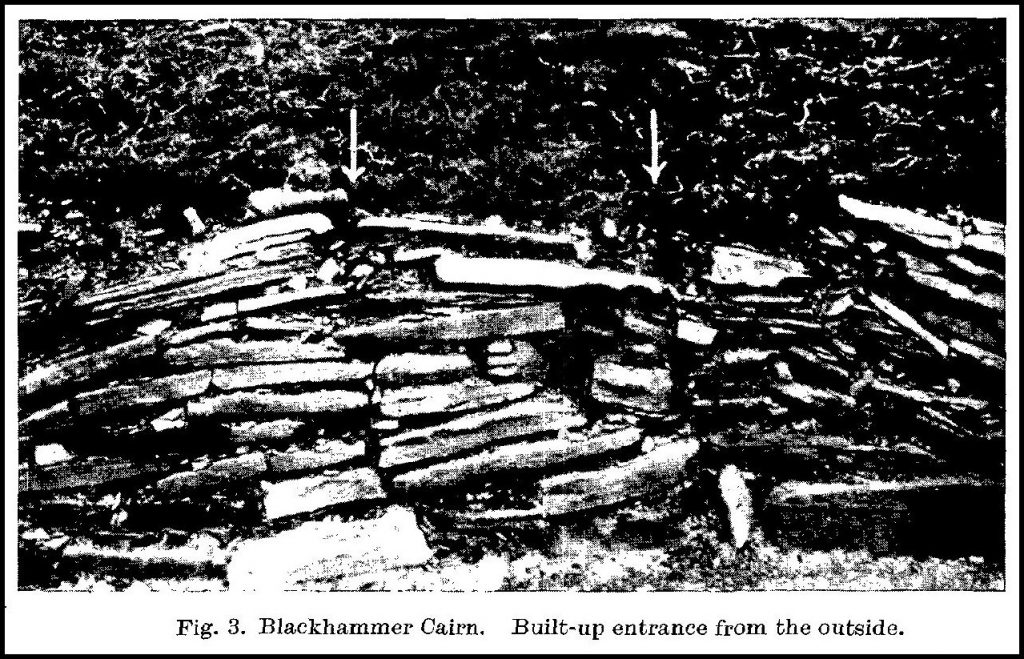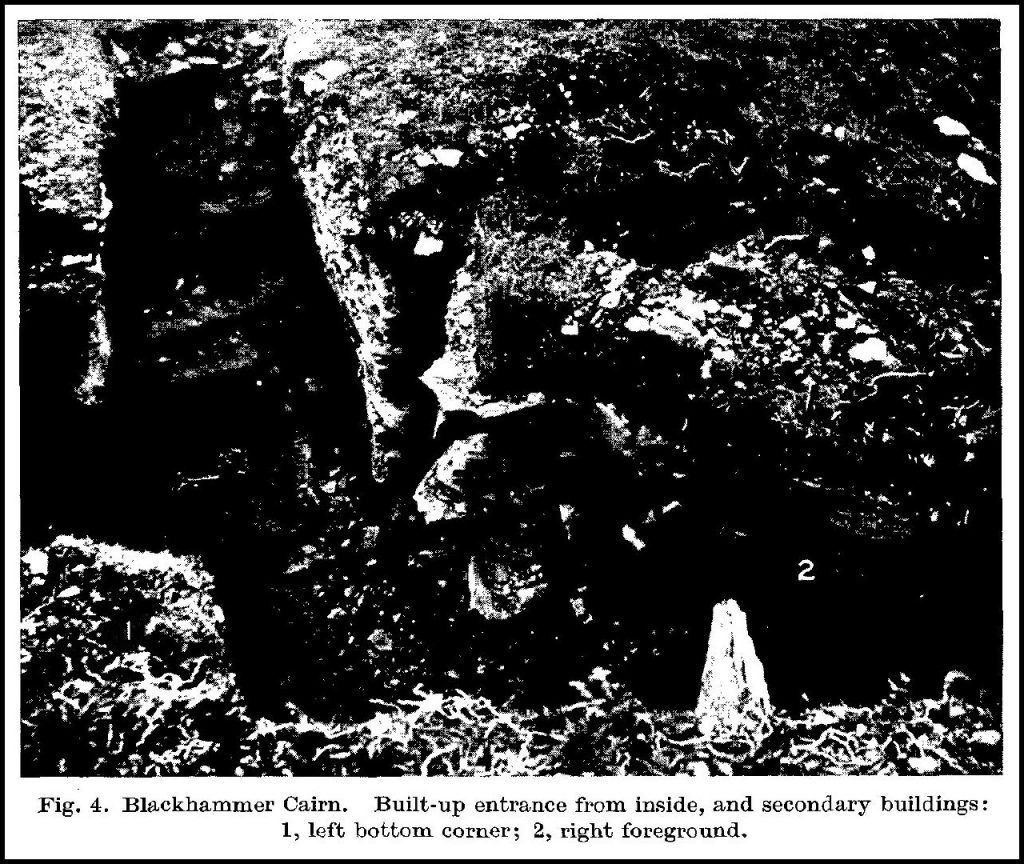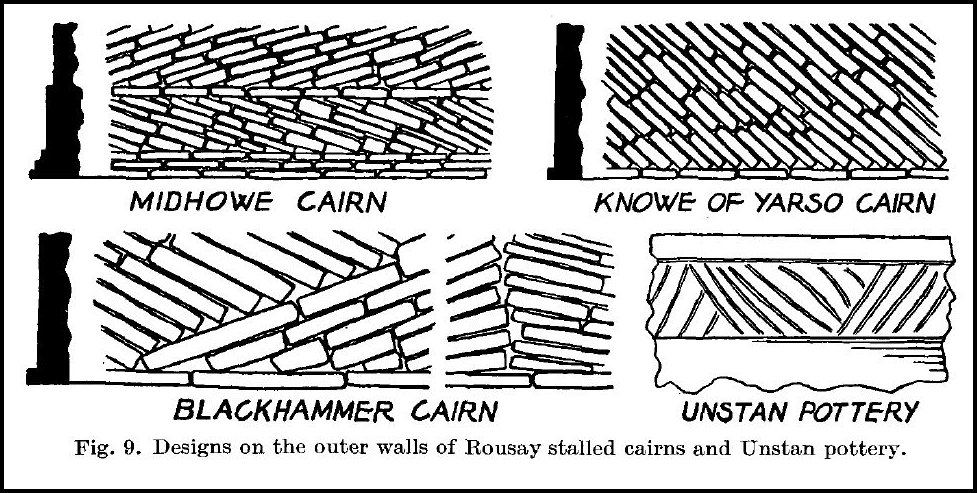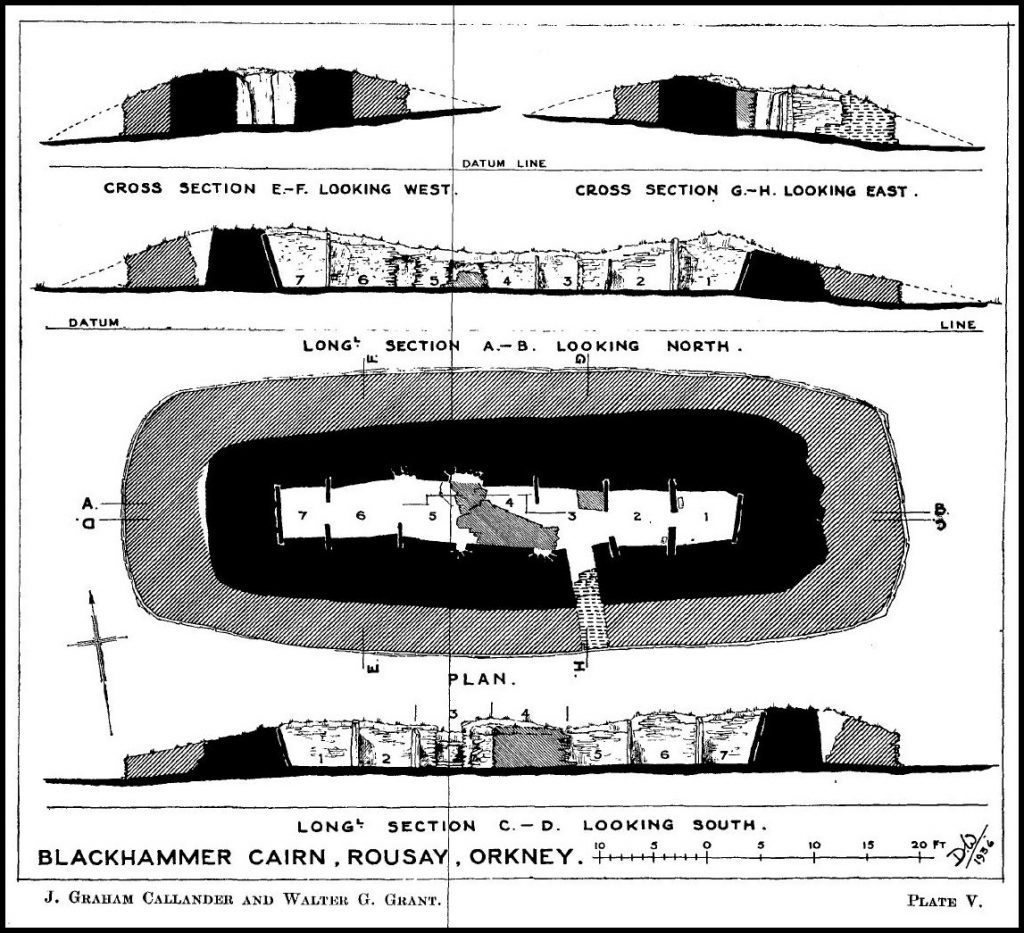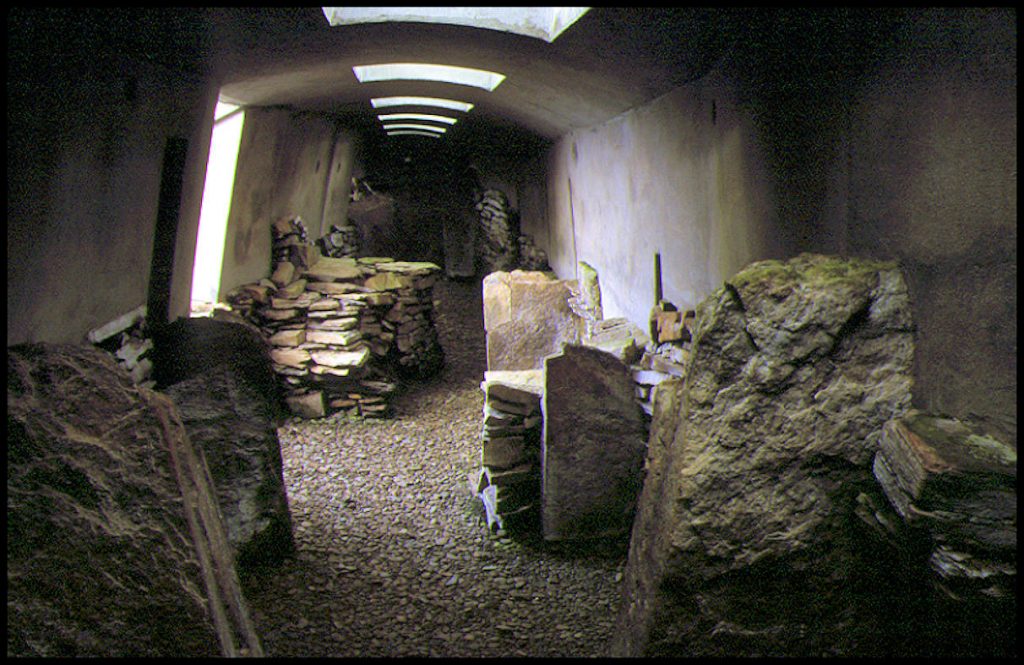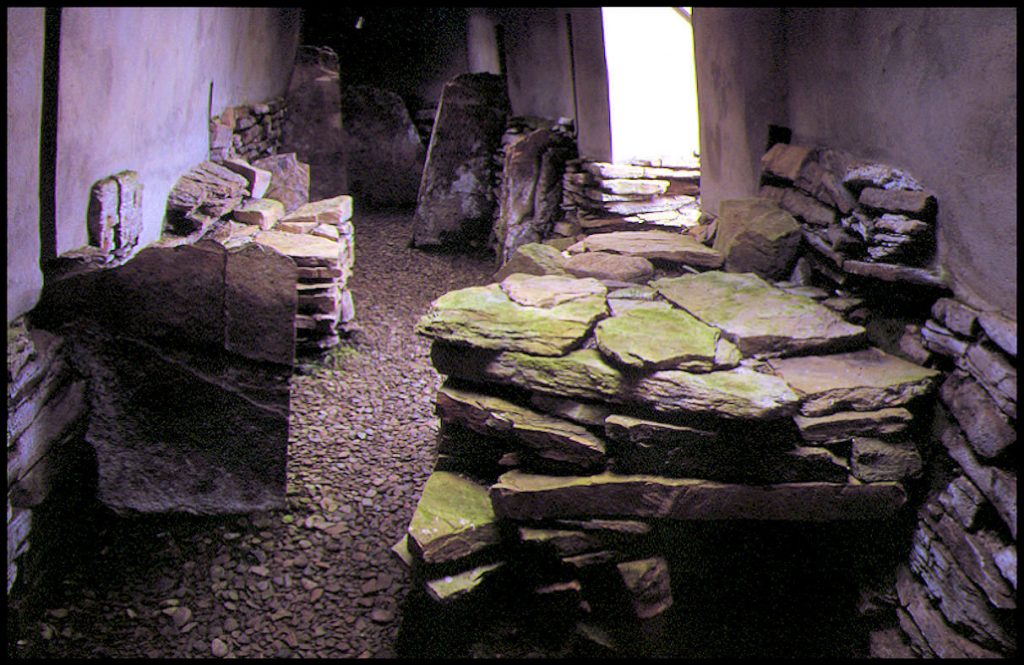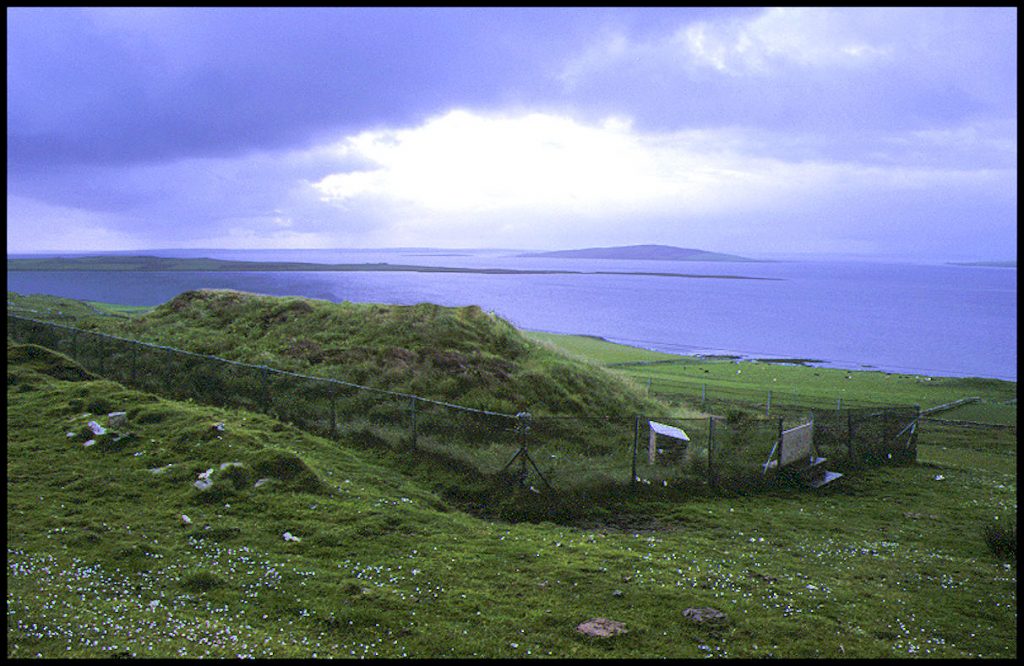LONG STALLED CAIRN AT BLACKHAMMER, ROUSAY, ORKNEY.
by J. Graham Callander, LL.D., F.S.A.Scot., Director of the National Museum, and Walter G. Grant, F.S.A.Scot.
Before this cairn was excavated it was just an oblong heap of stones covered with a growth of grass and heather, more suggestive of the ruins of a little farmhouse than of what it turned out to be, one of the most interesting of the stalled chambered cairns so far excavated in Rousay. It stands on a small flat shelf on the steep hillside rising immediately above the north side of the road which runs round the island, at an elevation of 200 feet above sea-level, about 450 yards north-west of the steading on the farm of Nears. The mound measured 78 feet in length, 34 feet in breadth, and 5 feet in height. Just above it, on a higher terrace, are the foundations of an old house called Blackhammer, after which we have named the monument.
The cairn, which is oblong with rounded ends and slightly convex sides, measures 72½ feet in length and 27 feet in greatest breadth (Pl. V). The upper part of the monument had been taken away to provide building material, so that its general height at present is about 5 feet (fig. 1). Its main axis runs about west by north and east by south.
When the outer face of the monument was laid bare it was found to be greatly reduced in height; at the east end it was 1 foot 8 inches high, at the west end from 2 feet to 2 feet 3 inches, along the north side generally 1 foot 6 inches, but near the east end only 6 inches; on the south side, from 2 feet to 2 feet 6 inches remained, rising to 3 feet 6 inches towards the west end. But, though only a fragment of what it must have been originally, it displayed features that had never been noted before in any Scottish burial cairn. One peculiarity was that no signs of an entrance passage into the burial chamber could be found, although this was carefully searched for – however, it was discovered later when the burial chamber was examined; another peculiarity was the way in which the stones had been laid – it was quite different from anything hitherto recorded.
The foundation course of the outer wall consists of a single row of flag-stones which project a distance of 3 inches from its face, so as to form a plinth similar to that seen in the stalled cairn, the Knowe of Yarso, which lies only 1000 yards to the west. For a short distance at the ends of the cairn the stones are laid horizontally, in the ordinary way, above the foundation, but along the sides the face of the wall shows a unique method of building. Though the stones are still laid on their flat faces, they are set not horizontally, but obliquely, forming a series of stretchers slanting down from right to left, and the adjoining ones from left to right, the result being a design of alternate hatched triangles (fig. 2) which recalls the decoration seen on some of the pottery found in the Unstan cairn. As in other stalled cairns which have been excavated in Rousay, and in the horned cairns examined in Caithness, the wall is double, the inner part being faced with ordinary building. This inner face has been traced at various places round the cairn and still maintains a height up to 3 feet 9 inches above the foundation; the interval between it and the outer face varies from 3 feet to 5 feet 4 inches on the sides, and 7 feet 3 inches at the west end, where there is a vacancy between the outer part of the wall and the face of the inner part.
As we have seen, when the outer wall was cleared of fallen material, no trace of the entrance passage could be detected, but this was discovered later on when the debris which filled the burial chamber was removed. It is placed on the south side of the monument and runs into the third compartment of the chamber from the east end. The reason that its mouth could not be found was that it had been carefully sealed up by a wall 5 feet thick, in the building of which care had been taken to lay most of the stones in alignment with the slanting stones of the outer face of the cairn wall (fig. 3); the inner face of this packing is rather roughly built, and has two rudely made steps (fig. 4) at the foot. The passage is 9 feet 9 inches long and 2 feet 6 inches wide. Its walls are now no more than 3 feet 6 inches high, the upper part, together with the lintels with which it was roofed, having been removed.
The burial chamber or gallery measures 42 feet 6 inches in length and from 4 feet 9 inches to 5 feet 6 inches in width, while the present height of the walls ranges from 2 feet 1 inch to 5 feet 1 inch on the south, and from 3 feet 2 inches to 4 feet 10 inches on the north side. The gallery is divided into seven compartments by upright divisional slabs set on end, in pairs opposite each other, and bonded into the lateral walls, leaving a space between the inner edges to allow passing from one cell to another, so that there are seven small stalls on each side (fig. 5). Four of the divisional slabs have been dragged out, two from both sides of the stall on the north side of compartment No. 5, and two from the stall on the south side of compartment No. 4. The upright divisional stones are dressed roughly flat on the top, and are from 2 feet 6 inches to 4 feet 11 inches high on the north, and from 3 feet 6 inches to 4 feet 6 inches on the south side. Their thickness varies from 2 inches to 8 inches and the extent of their projection from the walls from 14 inches to 1 foot 11 inches.
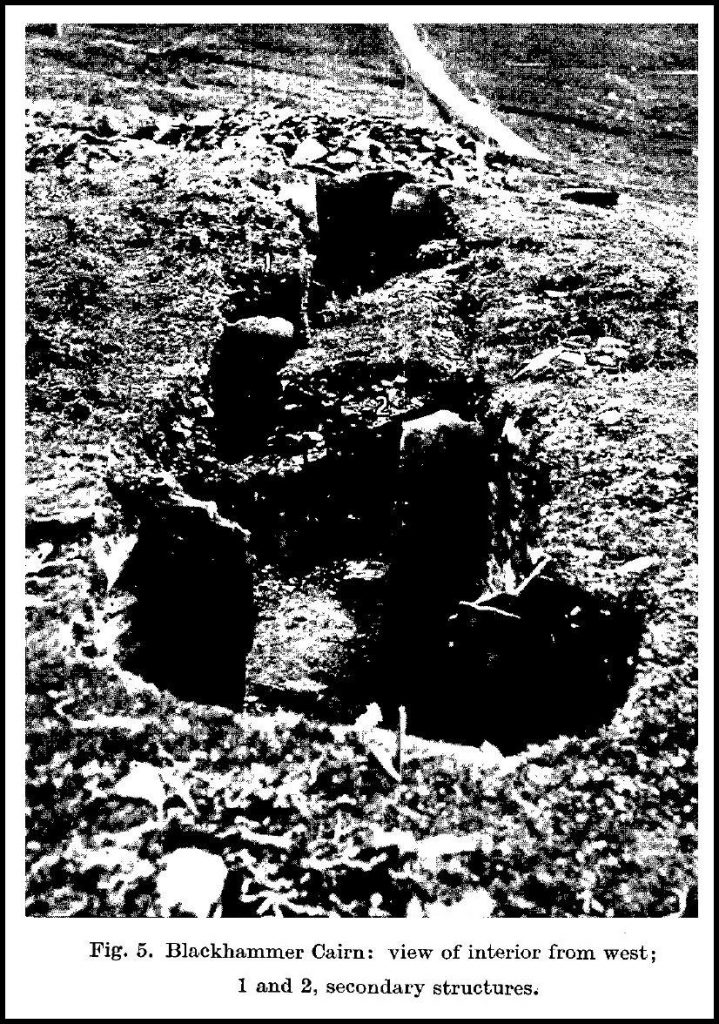
The stalls between the uprights range from 4 feet 9 inches to 5 feet 10 inches in width. The ends of the chamber are not finished by building, but terminate in a large slab set on end, that on the east being 4 feet high by 3 feet 5 inches broad, and that on the west 5 feet 3 inches high by 4 feet 9 inches broad. In the interior are two masses of later masonry of quite uncertain purpose and period. The first, which has been inserted in the angle formed by the north wall of the chamber and the slab dividing the second and third stalls, and almost opposite the entrance, is a buttress, measuring 2 feet 6 inches by 1 foot 10 inches by 2 feet 10 inches in height (fig. 5: 1). The second is a very rude piece of masonry, the building of which possibly accounts for the removal of the third and fourth divisional flags on the south, and of the fourth on the north side of the chamber. It springs from the south wall just west of the entrance, and follows an ogee curve obliquely across the chamber into the north side of the fifth stall from the east (fig. 5: 2). The faces are broken down except for a length of about 4 feet 6 inches on the north side, where it still remains 3 feet high.
We cannot suggest what these two intrusive buildings were meant for, nor can we say anything very definite about their date.
This is the second chambered cairn in Rousay to have the mouth deliberately closed, and that by careful building – the other being the Midhowe Cairn. In the latter, however, there were two sealing walls, one built in the mouth of the entrance passage and the other in its inner end. A third Orkney example, on the Calf of Eday, was brought to the notice of the Society at our last meeting, but in this case the whole of the passage was blocked up, the stone being carefully built in. These three cairns, it will be noted, are all of the stalled variety, but in the two others of this type excavated by us, the Knowe of Yarso and the Knowe of Ramsay, there were no indications that they had been sealed up. This peculiarity has not been noted in any of the other chambered cairns of Orkney and only in one of those in Caithness. This was in the large round cairn at Camster, where Dr Anderson found the entrance passage, 20 feet in length, completely filled with a packing of stones which “appeared to have been introduced purposely.”
A considerable number of relics were found amongst the debris – the fallen stones and earth – with which the burial chamber was encumbered. These consisted chiefly of animal bones, which were generally mixed through the debris, but they were most numerous at the eastern end of the gallery. Very few were found in the opposite end west of the entrance. In all likelihood this mixing had taken place when the upper parts of the monument were being removed in late times, and when the larger stones were being dragged out. We found that the same thing had occurred when the stalled cairn, the Knowe of Yarso, was being despoiled. The result was that stratification was not to be expected, except, perhaps, at the floor level.
Amongst the bones scattered throughout the debris at the upper levels and chiefly in cell No. 1 were those of sheep, ox, red deer, pink-footed goose, and cormorant. In the bottom layer were the remains of sheep, ox, red deer, and gannet. Many of the bones showed signs of burning or scorching.
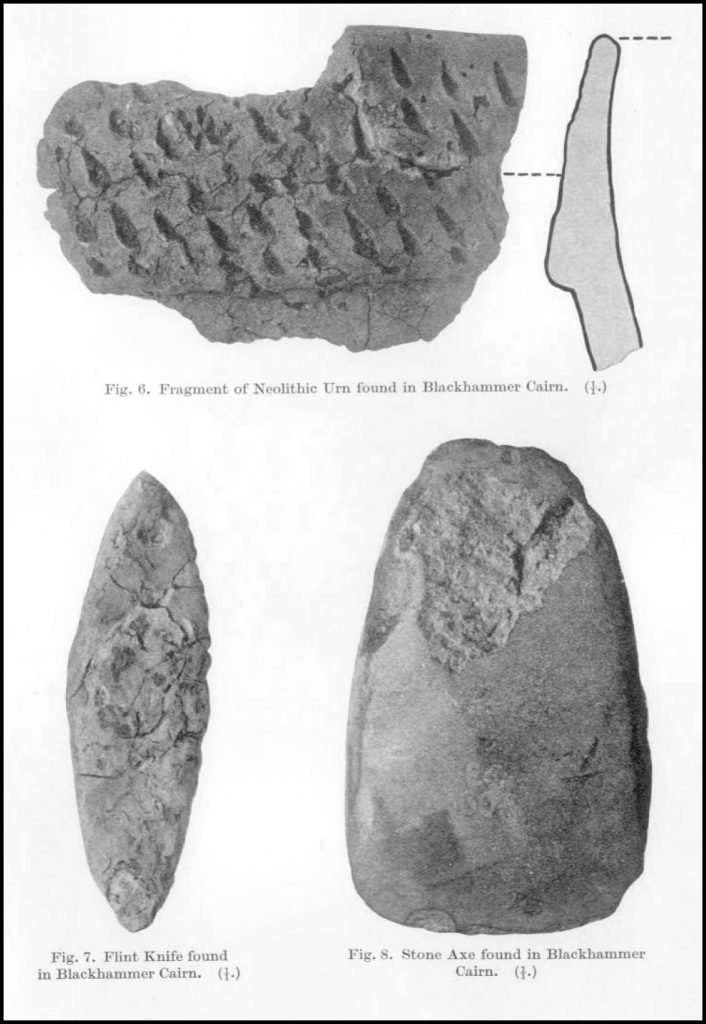
At the lowest level were found, in addition to animal bones, the much decayed and scanty fragments of two adult male skeletons, the greater part of a wide-mouthed shallow round-based urn (fig. 6), a finely made flint knife which had passed through the flames, as it was burnt white and splintered into pieces (fig. 7), and two scrapers and five splinters of flint. A stone axe (fig. 8), was also discovered at the same level.
The urn, which was of grey colour, was so cracked and crumbly that it was impossible to restore it. The greater part lay in a hollow in the floor of cell No. 6, 2 feet from the south wall, and the same distance from the divisional slab on the east side; the remainder of the vessel lay near the centre of the cell. The urn had measured about 8 inches in diameter at the mouth, and the wall between the brim and carinated moulding where it turns into the round base measures 1⅝ inch in height. This part is decorated by five horizontal lines of pear-shaped impressions. The thickness of the rounded bottom is 5/16 inch. The flint knife after being put together again was found to be leaf-shaped and carefully dressed on the upper face, the under side being plain. It measures 3⅜ inches in length, 11/16 inch in breadth, and 9/32 inch in thickness. The two scrapers and five splinters of flint, of which four were calcined, were found at the lowest level in cells Nos. 1 and 3. One of the scrapers and a slightly worked splinter lay under the step behind the piece of walling which closed the mouth of the entrance passage. The stone axe, which measured 39/16 inches long, 2⅛ inches broad, and ⅞ inch thick, was found about 6 inches above the floor, 1 foot out from the south-west corner of cell No. 1, animal bones being found above and below it.
Although Dr Anderson had drawn special attention to the double outer walls which he had discovered in the horned cairns of Caithness, and had remarked on the concentric circular walls in some of the chambered cairns of Orkney, it is doubtful if archaeologists had really visualised what finely built structures these monuments were. It has only been during the last four years, after the long, stalled cairns on Rousay, and the circular cairns at Unstan and on Wideford Hill, were stripped of the accumulations of soil and fallen debris with which they were encumbered, that it has been realised what striking monuments they must have been – that instead of consisting of conical mounds of stone piled up over the burial chambers they were elaborately constructed houses for the dead incorporating distinctive, ornamental, architectural features. In the horned cairns of Caithness and in the round cairns and stalled cairn, the Knowe of Ramsay, in Orkney, the outer wall shows orthodox building, with the stones laid on bed, but in the long, stalled Midhowe, Yarso, and Blackhammer cairns the face of the wall is built so as to display such ornamented designs as those seen in fig. 9.
The long, stalled cairns of Rousay and other Orkney islands have generally been so much despoiled that we have no idea of what their original height was, and we can only imagine how the roofs were finished off. They must have been distinctly higher than the tallest of the divisional slabs between the stalls, which in the case of the Midhowe Cairn was 7 feet 6 inches. As for the form of the roof, it would naturally be carried up to form a curved top with the stones being laid on the slant to throw off rain-water. In the round cairn on Wideford Hill, which has three concentric walls, even though it is greatly disturbed on the top, the stones have been laid slanting downwards towards the outside.
The opinion has been expressed that these long cairns had been finished off by heaping soil over them, but surely no people were going to erect buildings with such striking architectural features with the intention of hiding them under a screen of soil. If any argument against this is necessary it has only to be noted that the Knowe of Yarso is built practically parallel to the edge of a ragged cliff, too close to it in places to provide a wide enough foundation for a covering of soil.
REPORT ON THE ANIMAL BONES
by Margery I Platt, M.Sc., Royal Scottish Museum.
The animal remains from Blackhammer constitute fragments of the skeletons of domestic species principally, although relics of the Red Deer (Corvus elaphus, L.) are also present, together with a few bones from birds of the sea common in these islands. In most cases the fragments are small and too broken to classify with certainty. Ribs of domestic stock are most numerous, and the relics throughout show evidence of fire. Sheep remains predominate, whilst oxen and red deer are represented in equal proportions.
The bones submitted appear to be derived from two layers designated “Top” and “Bottom” Layers, and the various species found in each of these are cited in order of their numerical importance. Most of the bones were found in cells Nos. 1 and 2, the larger number being found in the former.
Top Layer.
Sheep. – Many lower jaws with teeth indicate sheep of a large size. No horn-cores occur, and therefore it is impossible to determine the breed. From the lower jaws it is possible to estimate the number of animals in this section. There are six right mandibles with full adult dentition, four left ones from immature sheep, whilst twelve permanent lower molars found singly make it certain that at least six other sheep were present. In all, this indicates a minimum of sixteen individuals, of which one-quarter are immature. Limb bones and ribs, all fragmentary, complete the relics of this species.
Ox. – In addition to a fragmentary scapula and terminal phalange, the whole of the bovine remains comprise broken pieces of rib. It is therefore quite impossible to ascertain the breed represented or the actual numbers present.
Red Deer (Cervus elaphus). – The remains of this species, as in the case of the ox, are almost entirely composed of fragmentary ribs. They vary in size and thickness, indicating that young and old deer occur, but no estimate of their number can be given. There is a single piece of antler of medium size.
Birds. – The bird relics include the wing-bone of a pink-footed goose (Anser brachyrhynchus, Baillon) and the pelvis of a cormorant (Phala-crocorax c. carbo (L.)).
Chamber 1 – Bottom Layer.
Sheep. – Sheep remains in this section are again the most plentiful. Fragments of left mandibles prove the presence of at least eight sheep. All the dentitions were adult. Other skeletal remains of this kind indicated full-grown sheep of large size, although evidence of the actual breed could not be found.
Ox. – Bovine relics were not so numerous as sheep. Fragments of ribs, limb bones, and pelvis composed the majority of the remains. No definite breed, in the absence of horn-cores, could be recognised.
Red Deer (Cervus elaphus). – The remains of this species were as equally numerous as those of the ox. Fragments of ribs were again plentiful. A few ulnae, a good sacrum, and three pelvic bones also occurred. In no instance was there any indication that the deer differed in size from those of the present day.
Bird. – Two pieces of the wing-bone of a Gannet (Sula bassana) were the sole avian relics at this level.
REPORT ON THE HUMAN REMAINS
by Professor Alexander Low, M.D., F.S.A.Scot.
Bones found in Chamber No. 7.
The fragmentary human remains include: Supraorbital part of frontal bone with marked ridges; some 6 pieces of rather thick parietal bone; pieces of left upper and lower jaws with 2 molars and 2 premolars in upper jaw and 2 molars and 1 premolar in lower jaw, crowns much worn down, but powerful teeth; fragments of right side of male pelvis; fragments of right and left femur. One adult male skeleton.
Bones found in Entrance.
The only skull-bone represented is a fragmentary lower jaw and some teeth; 13 fragmentary vertebrae; left half of a pelvis probably male, and pieces of sacrum; some 16 fragmentary ribs, amongst which can be identified a right first and a second left; fragments of right and left scapula; right and left clavicle; fragments of left humerus and of right and left radius; 1st, 2nd, 3rd, and 4th metacarpals of right hand and 4 proximal phalanges; upper two-thirds of right femur; pieces of shafts of right and left tibia; 2 pieces of shafts of fibula and lower third of a right fibula; fragmentary talus and os calcis. Numerous fragments but no duplication. One adult male skeleton.
Extracted from
The Proceedings of the Society of Antiquaries of Scotland,
Volume 71, March 8th 1937 pp. 297-308
Available in the Orkney Room at Orkney Library & Archive
……………………………………………………
